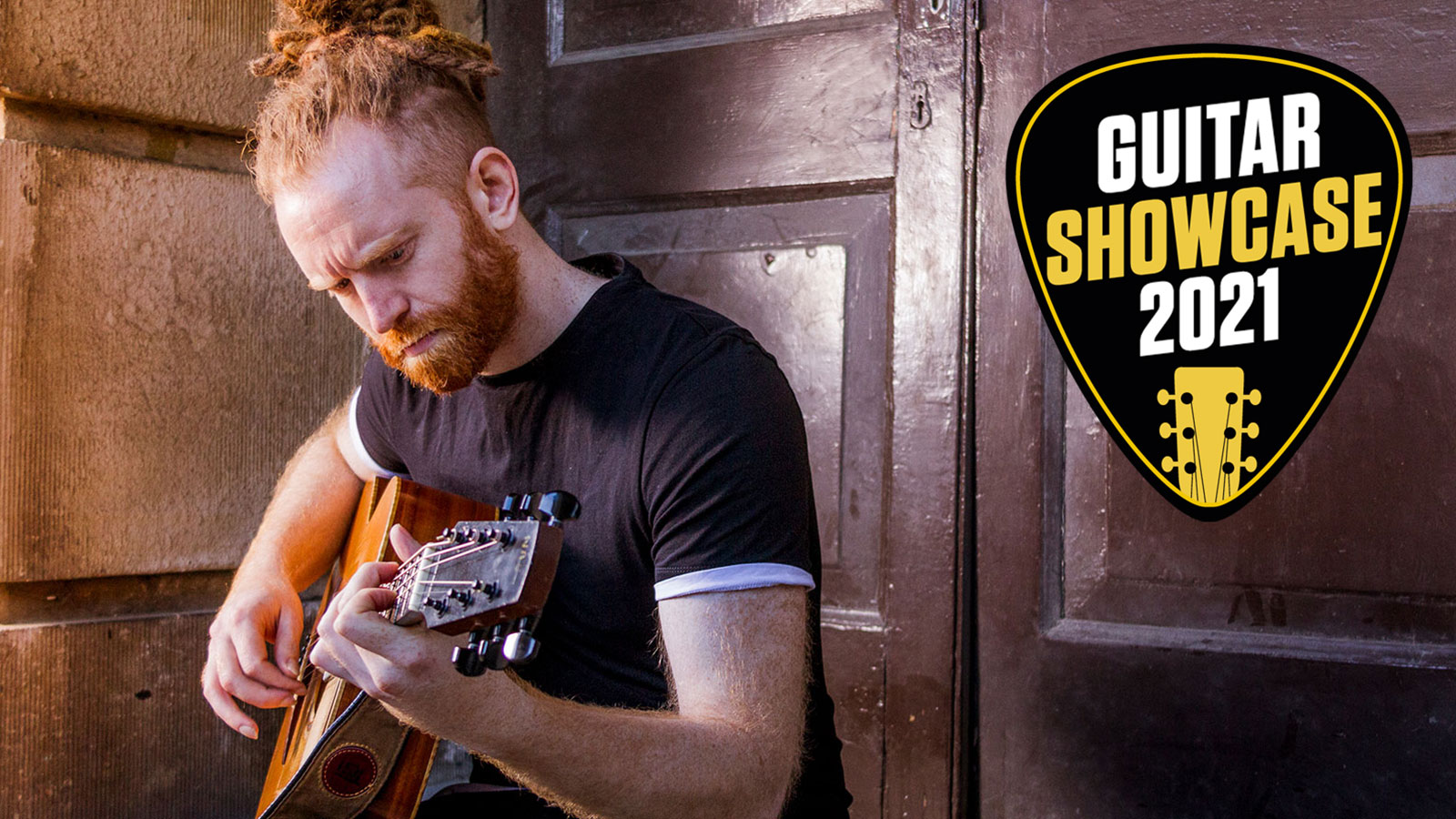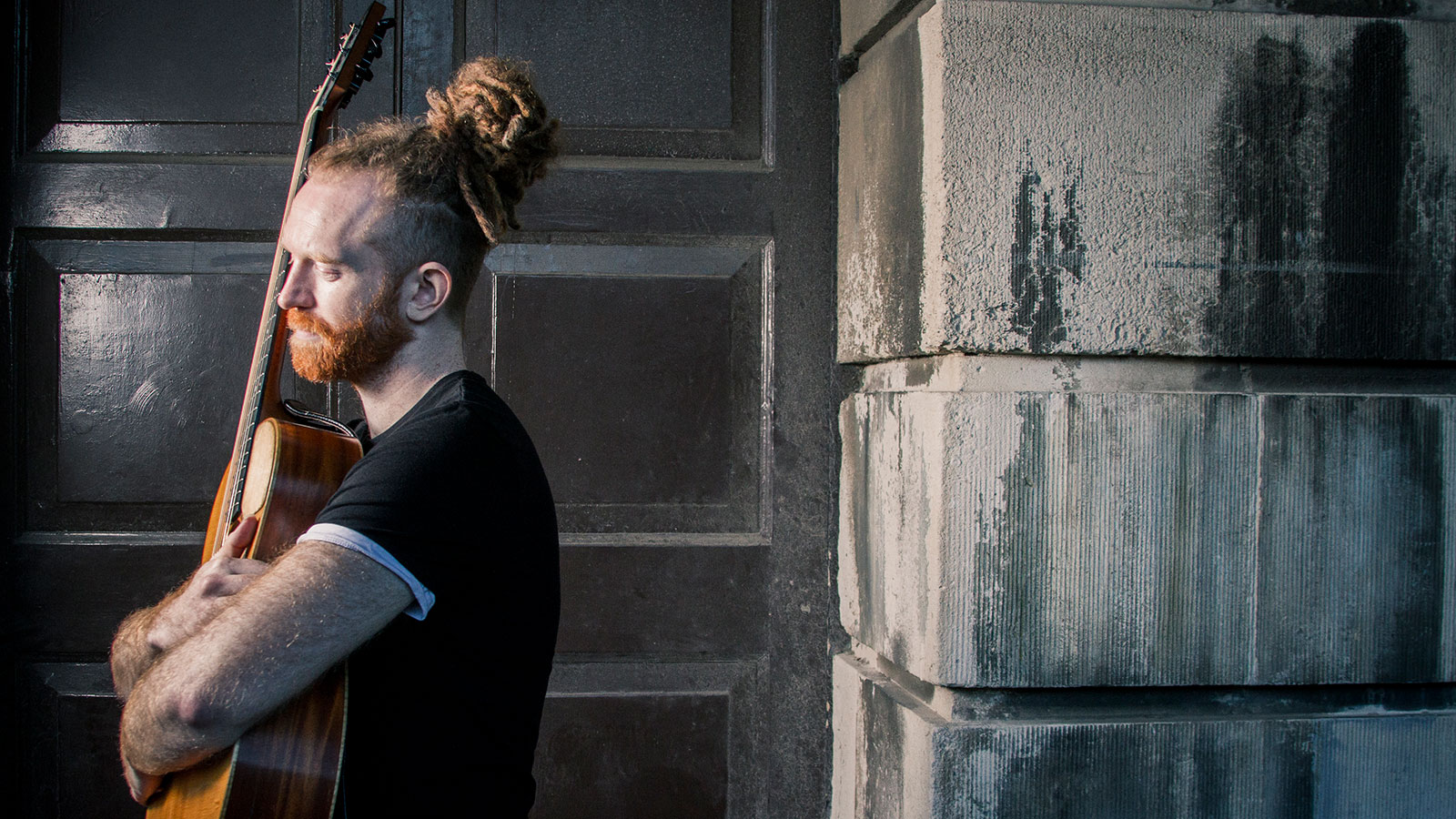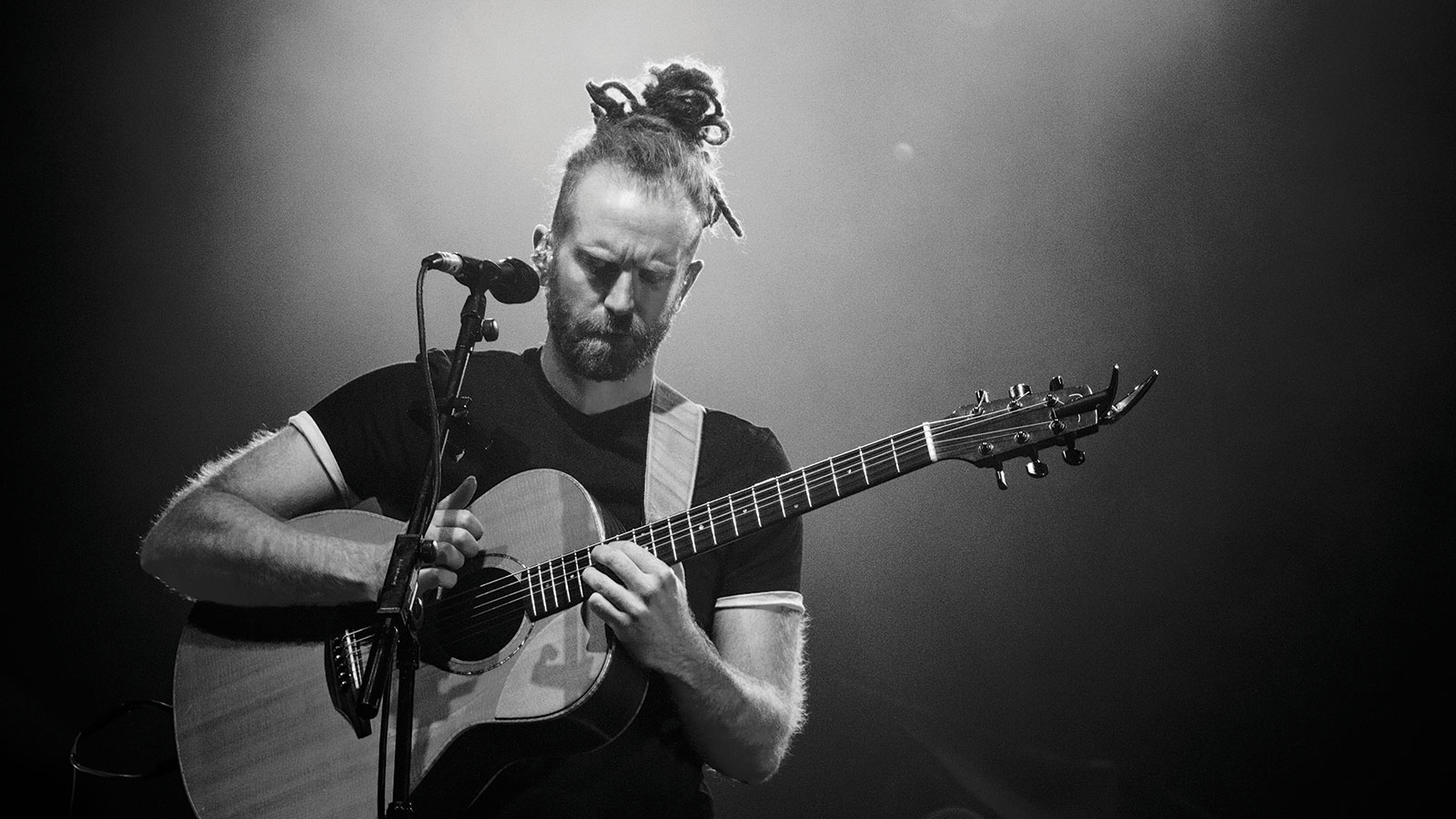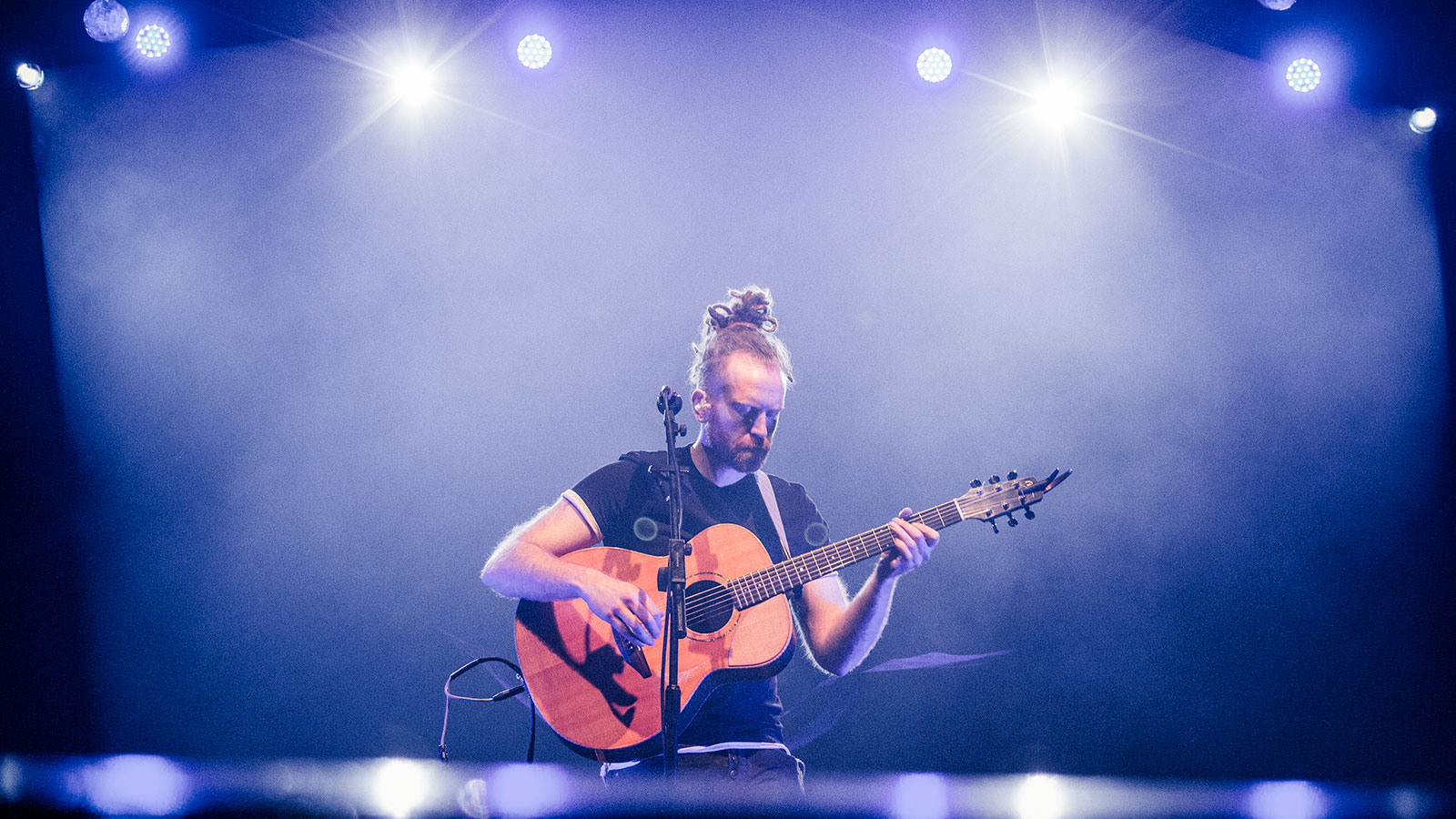Guitar Showcase 2021 interview: Newton Faulkner reflects on his lockdown album, and the tech that forms his new live sound
The benefits of building a rig from scratch, finding your own space and how the high times of guitar tech we live in can feed into your creativity

Guitar Showcase 2021: Newton Faulker took some time out of his soon-to-be hectic schedule to talk to MusicRadar about the album made during lockdown, but written for better times.
Four years since his last release, he discusses highs, lows, optimism and a new approach to live performance, with some tech tips along the way. As well as some deep insights on flying a - err - musical helicopter.
So let’s deal with the elephant in the room. Lockdown...you did a lot!
“I did! In maybe not the healthiest way at all times. There were times when I was working because I just wanted to, was happy doing it, and I was like “oh this is nice, crack on make an album that’ll be lovely”, and there were other times where I was working in a kind of obsessive, borderline mental disorder area of obsession with the work, which I think I was aware of, I knew it was happening but I thought ‘let’s see where it goes’.”
There were certain tracks where I almost had...aggressive vendettas against them. It was like ‘I will find a groove that works for all the different sections of this song, whether you like it or not’.
“I worked crazy hours. In fact one of my favourite times to work is really early. So I like getting into the studio at about half six, seven and just getting on with stuff. I think it’s partly because if [other people] are awake, they’re not talking to me. There’s this bit where I’m not getting loads of texts, not getting loads of emails, not getting notifications all over the place; it’s pretty quiet in the world and I can just get on with whatever it is I want to get on with.
“And then also, the other advantage is that enough of my brain is awake to just throw ideas around, but it’s like my awareness of pressure and my fear doesn’t wake up until about nine o’clock.”
When the rest of the world wakes up basically?
Want all the hottest music and gear news, reviews, deals, features and more, direct to your inbox? Sign up here.
“Yeah! When the world starts creeping in suddenly I start doubting things but there’s this clear patch in the morning where I’m really just open to way more stuff when I throw loads of ideas around and play loads of instruments and get on with getting carried away, being creative.
“I’ve always done that but I haven’t usually kept going until it's dark and really late! There were certain tracks where I almost had...aggressive vendettas against [them], and it was like ‘you will not beat me’, ‘I will find a groove that works for all the different sections of this song, whether you like it or not’.
“I just really dug in. I think the longest I spent on any single track was probably Better Way, and I think I spent three and a half/four months. Every day. My partner, who lives with me, would ask; kind of closing one eye hoping that the answer was going to be something else!
“I work in a soundproof room but it's soundproofed in all directions other than into my own house.”
You’re probably echoing the sentiments of every partner of a musician during lockdown
“Yep!”
Finding that headspace that you find earlier in the morning, did you find that lockdown augmented that and you could go further into the day?
“First lockdown; I didn’t do a single thing. And I kept trying to. But everything felt so strange and wrong and I would come into the studio and just stare out the window. I felt kind of frozen. And it lasted much longer than I thought was possible really.
“At that point I had no idea how long it was going to go on for, had lots of stuff cancelled and then it was just a matter of making enough sense of it to function, which I didn’t do in the first lockdown. By the end of the first lockdown and things started opening up again it was like ‘that happens now? That’s a thing that happens…?’
“Second one I was like...right I can’t just stare out the window again, let’s just really dig into a project. I did and then I kept going through that one, through the other ones. Even when everything did open up, I didn’t take advantage of it, I didn’t feel like I could...I was still digging into stuff. It was a lot of things that happened previously that are kind of huge, very emotionally challenging, difficult life events that happened.”

“A huge thing came to a conclusion - I think in early February - and then I was just trying to find my feet again and then the lockdown came in. Suddenly, working for years to get to the point of where a situation was resolved, and then some other stuff happened at the same time...loads of really heavy stuff. Instead of dealing with it in a healthy way, I kind of just shelved it and got on with work.
Instead of dealing with lockdown in a healthy way, I kind of just shelved it and got on with work... Then I finished the record and totally crumbled
“I didn’t really really realise the extent to which I’d done that until I finished the record and totally crumbled. Everything hit me...ironically a lot of stuff I was saying on the record was stuff about acceptance and accepting things that you can’t change and come to terms with things and forgiveness, and all this stuff was wrapped up in the album, which I genuinely believed I was doing. But I guess if I was doing it I wouldn’t feel the need to sing about it.
“So all the stuff I was singing about...I didn’t do until afterwards, and after the record was finished I had to take quite a lot of time off afterwards. I was completely non-functioning.
“It was during that time I think I learned more about myself than in the previous several years. Really weird mental journey. Probably the same as everyone, it was a huge time of introspection and working out what is important to you and what you actually want to achieve and get out of life. It’s crazy.”
It’s not an unusual story where someone throws themselves into work and creates that little bit of distance until their head is ready to catch up with where they are...
“Yeah, and I think [there’s] a little bit of that every tour. Definitely in the past. I think it was very much put it in a box, lock the box, dig into wherever you’re doing, then as soon as you have done that, then you can come back to it. It’s the worst way to live your life, in retrospect.
“It doesn’t work and it explains so many things that happened over previous years. There was a point where I was ill at the end of every tour and it was because I locked everything down...at the end of a tour I’d feel horrendous and have to spend a week in bed.
“It’s fascinating. I’m now, every morning, try[ing] to take everything in and feel everything I need to feel and clear my decks and move forwards with everything. It’s had a huge impact, and definitely workflow has been so much easier.”
There’s a definite feeling of positivity on the record, and not knowing the inside story, it felt reactionary to everything that was going on outside.
“I was very conscious of not wanting to write a record for lockdown. I figured - as fun as it all was - it probably wasn’t something people were going to want to mentally revisit immediately afterwards. Or probably quite a long time! So I was conscious of writing it for coming out of it and being the other side of things, and I think that’s where a lot of the concepts came from.
“This has happened, and it’s now getting to the point where...you can see the sun rising. All of the ‘sun is coming up’ analogies came from me wanting to write for further down the line.”
Presumably the idea of doing a tour was a nice light at the end of the tunnel?
“Well the first half of this tour sold out two years ago. Which is just insane to me. The first gig is this Friday, part of me is ‘I’ve got a gig this Friday, that’s amazing’, part of me is like ‘you can’t have a gig this Friday, that’s not how it works anymore’. There is going to be a little bit of ‘you’re actually here! And I’m actually here!...’
The first bit of the pedalboard puzzle is a Headrush looper, it does all kinds of crazy wizardry, it’s an amazing piece of kit
“The set scares me but it scares me in a really good way. It’s really nice to not be going out with just an acoustic guitar...there’s so much more to it. Obviously that’s always going to be a massive part of what I do; there’s a huge section of the set that’s just acoustic guitar and all the percussive stuff, but in terms of recreating this record live, I’ve had to take a huge leap into technology and in to live sonics, and it’s been really fun.
“I’ve never really worked directly with people that build shit before! I’ve been working with Nick Benjamin, who I’ve been working with for years and he’s amazing and I love his stuff, and it’s wood and strings and obviously there’s an electronic element and we’ve always been very detailed on that level but in in terms of being able to have a FaceTime with the guy that built a thing and be like, ‘Hey I’ve been trying to make it do this and it’s wrestling with me’ and I’ve never had that before.
“I’ve had techs that are dealing with people and asking questions but it’s never been directly through me. And I’ve never built a live rig from the ground up just on my own, which makes so much more sense then because if anything goes wrong I am the only person there!
“Nick built me a pedalboard...it’s amazing, it does everything. I have no idea of the signal path and that is not OK when it goes wrong. I’m looking at it thinking, well I think we can all agree “that’s not...um...working”. With this massive pile of equipment behind me, I know every stage of everything, because I put it together myself. Started with one bit of equipment, got my head around that.”

“The first bit of the puzzle is a Headrush looper, it does all kinds of crazy wizardry, it’s an amazing piece of kit, I’m still getting my head around each layer, because you can make it do loads of different things. What I’m doing for this tour is I’m going to set it up and make things fit with that way of working. I can work in some of the ways it can work but in general I want to make it stick to one thing.
“They [Headrush] came to me a couple of years ago, and at the time I was not gonna use it. At the time I was doing something that nobody understood. I was multitasking to the absolute max, to the point that I had pains in my brain, computing all the polyrhythms and doing all the stuff.
“For 98% [of the audience] they just wanted me to perform and connect with the songs, and just wanted to see interesting things. It wasn’t visual enough. It didn’t translate in that way because I was doing so much stuff with my feet that people couldn’t really see.
“They didn’t understand that the piano and bass were on one foot, and kick drum from another and the snare was coming from the back of my nail on the inside of the guitar...and then there’s pianos that I’m occasionally grabbing, triggering from random things and all this stuff that was all happening at exactly the same time...all individual samples being triggered. But everyone assumed that it was either backing tracks or loops...Even if I explained I feel like people didn’t really understand.
“With Teardrop for example everyone goes away thinking it’s clever, even if they know nothing about guitar, partly because it’s a song that they know...they go [makes percussive guitar noises] ‘that’s clever’.
“It has to, sonically, sound good, it has to be visually impressive and I have to connect with the material and perform material, not just run it like some weird maths show. With this setup I can go so much further into what my records actually sound like, because I’m triggering samples from the records. I've been working with Boss and Roland with loads of their stuff to get further into what’s possible to do with guitars these days, which has been incredibly eye opening.”

We’re living in a pretty mad time with guitar technology at the moment
“I use the SY1000. If anyone knows this bit of gear it might make them really nervous, because I think a lot of the stuff I’ve seen people do with it is obviously the most extreme stuff it can do, and obviously that’s great that it can go that far but the sweet spot is somewhere in between. It’s finding the right layers and the right stuff for that. For me the weirdest bit is that you can change the tuning without touching anything. That just makes me feel so strange.
With the SY1000 I can turn the guitar into a bass guitar with one button that’s on the body of the guitar
“But between the samples from the record, I’ve got the keyboard as well and the bass pedals I’ve been using for years...they’re being used quite sparingly, whenever I really need to do two things at the same time, I can.
“So... the Roland Gaia, the SPDX (kick drum, triggers), bass pedals, then the looper that everything goes through, then the SY1000 going through a guitar that was built for me by Nick Benjamin (which is an electric that is built to be played fingerstyle - I’m still finding more tricks that it can pull off), and then my whole acoustic setup with all it’s routing and strangeness there, so between all of that there is SO much it can do.
“There’s sections where I’ve got everything up and running and I can just sing. I’ve never been able to just sing! After all these years of playing and singing, playing stuff; stuff that relatively few people can physically play, and doing all of that to that level of complication, to just singing to people…”
That must be quite...liberating?
“Really interesting, yeah.For me it’s the missing piece of the puzzle in some ways. Something like There is Still Time...it’s kind of a duet between voice and guitar.
“For the live stuff there’s all these other records that have all these big sounds and have big drums...something like Sinking Sand is so much fun live and it’s a place I’ve always wanted to go. I love the vibe of it...to be able to get to a stage where that's the opening of the show, these massive triggers and disgusting guitars and super gross, big, aggressive noises...it’s somewhere I’ve always wanted to go. I don’t just listen to one type of music...I do listen to an incredibly wide scope of different things. And for me being able to get to that point live and to be able to do it solo…
“The difference between all those previous records and this one is that I played all the parts, so I know what they are...I sampled those drums and put them back into the SPDX so I can have a click in one ear and play the part on guitar, and then with the SY1000 I can turn the guitar into a bass guitar with one button that’s on the body of the guitar anyway, so the bass parts I played on the record - and the tones are astonishing really - I have access to. Everything I played on the record, which is really exciting.
“There’s sections of tracks that I’ve programmed in, but I’ve never really been able to tap into live - like a thing on World Away, a really dance-y little thing which I remember tapping in with my finger on a little Akai keyboard, and now being able to play that on an SPDX with sticks whilst hammering on a kick drum - that’s something that has always been a part of what I do but I just haven’t had access to it. So it’s really interesting that it’s gone in both directions at the same time. I feel massively liberated and much free-er because I’m not locked in.”
“The other thing with multitasking is that you have to sit down because you need both limbs, and it’s kind of like playing violin. I think the most insular of instruments, because the sound hole is right by your ear, that I feel you play to yourself. If you’re locked into something it’s there, it’s in a bubble...you’re kind of flying this musical helicopter...you’re pedalling just to keep this thing afloat.
“I feel with this setup, I’ve got multiple mics, I can use the stage to move around. It’s gonna be a lot more visually stimulating. A lot of the times when I’m singing I’m not doing a lot of stuff at the same time, I’ve done a lot of the things and different points and I can really commit to the meaning of the songs and dig in. It’s not gonna be a crazy layered loop-fest every song! I’m always gonna go back to doing stuff that’s just acoustic.
“One tour I did it with just one mic, Alison Krauss and one condenser vibe, so it’s going back to that and expanding. So it’s going to be a live show where you come away and think “wow, I really felt all of that”. I feel like I wouldn’t want to see me, with just an acoustic for two hours off the back of this record. For me it doesn’t make sense. It’s something I will do , but for this record I want to branch out. I want to come back to it but I want to be able to go to places I haven't gone before.”
So is the enabling of you being able to recreate these sounds live influencing the way you’re going to approach the next record?
“Definitely. I’m kind of already thinking two or three albums ahead. The next project I think I know where it’s gonna be, then another and I think I know where that is - dramatically different from each other. But I think there’s definitely stuff I use live that I’m definitely going to use on record.
“There’s so many things, and possibilities. One thing I’m looking forward to doing, is that once I’ve done this tour where I’m recreating the same sounds, then tours in other places like in America where I’m gonna have to come up with completely different arrangements, that are just acoustic, but recreate the same stuff that I’ve been doing with all the bells and whistles. I really enjoy it, it’s like the version I did of Teardrop but with my own songs.”

You mentioned earlier your electric that’s designed to be played like an acoustic (Frank) - is it strung the same?
“Yeah there’s still Elixirs on there - my string gauges have gone through the roof in terms of thickness, I mean - I’ve got a 70 on the bottom of my acoustic. Part of the way the strings react to the pickup, like the higher the string tension, the more direct and tight the sound is, so punky and a meaty sound. Which is great for the strum-y things and the tapping - all that stuff - translates so well. I mean - it’s not the easiest to play! Like playing a giant bass at times! Every note you really have to commit to.
“I call [that guitar] Frank - most of my guitars have got silly names - but with Frank it’s not crazy heavy, although it’s in C at the moment. But it’s partly that lower string tension rattly, electric thing, take a track like Killing Time, those strummy guitars...they’re quite rattly. But if it was rattly on an acoustic guitar it would be bad but the rattle on an electric is kind of cool...has a different vibe to it. More punk. Nice. Reassuring in some way.”
With Nick Benjamin’s guitars, a lot of them have numbers, and he wanted me to have one, two, three, because he thought I’d find it amusing (which I did)
“It’s Getting Late is Frank’s golden moment - pure Frank - going through an AC15, no effects, just tremolo and a bit of reverb - that’s probably my favourite guitar sound on the record. It’s so...loud and so quiet at the same time. If I hit it hard it’s totally mental guitar noise. An amp pushed hard, and then played really gently.
“You’re aware that it’s folding itself in a really tight, small space, and if anything went it would fucking GO, but I like that tension in it. It really works for the song. It’s crazy on the bends, like a pedal steel. It’s a very surreal sound. I don’t know if anyone’s ever put a label on it, like Tom Wait’s version of Young at Heart. There’s this kind of surrealist country...it’s in that kind of vein.”
So let’s get nerdy…
“Elixir gave me a bunch of strings and they genuinely lasted a really long time. I spoke to someone there recently who sent me a year’s supply of strings...I mean; I think at that point I was changing strings every gig, which isn’t necessary. But with the string gauges I use...I very rarely break strings. Mainly when it’s happened it’s been from tuning up and down a lot, but one of the things I’m really enjoying is the fact that with the Boss SY1000 I can tune the strings without tuning the strings.
“It’s just meant that there’s a couple of songs that have some crazy weird tunings, which when I was recording was just placing some random string on the wrong place on the guitar, which is great when you’re in the studio but when you’re travelling..so I need a whole other guitar...for one song it would be ok, but for the last four barres of that one song seems a bit ridiculous. So being able to tune up there..it’s amazing.”
So give us a rundown of what you’re taking on tour…
“With Nick Benjamin’s guitars, a lot of them have numbers, and he wanted me to have one, two, three, because he thought I’d find it amusing (which I did), so there’s one I call “the scoop” which has got a cheeky little scoopy cutaway, and then there’s Frank that's also on the road.
“It’s actually the least guitars I’ve taken in a long time, but the most noise. Then you get into the other stuff. There’s two pedalboards for the two acoustics, which actually has a Bose T8 mixing desk on, just to route all the acoustics to all the appropriate places.
“There's an OC5 and a blues driver that has its own channels and own compression, before it goes anywhere else, and that goes to front of house, so that does a huge amount of work. There’s also an SPD-1...I think everyone should have one - doesn’t matter if you play guitar or do music - they’re just useful. It does the same job as a stompbox, but totally consistently and with way more control and it sounds the same wherever you go. It’s a really useful piece of kit for solo gigging.”
Newton Faulkner is on tour right now, head to his official site for more information.